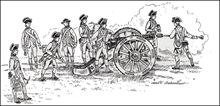
Artillery is a class of heavy military ranged weapons that launch munitions far beyond the range and power of infantry firearms. Early artillery development focused on the ability to breach defensive walls and fortifications during sieges, and led to heavy, fairly immobile siege engines. As technology improved, lighter, more mobile field artillery cannons developed for battlefield use. This development continues today; modern self-propelled artillery vehicles are highly mobile weapons of great versatility generally providing the largest share of an army's total firepower.
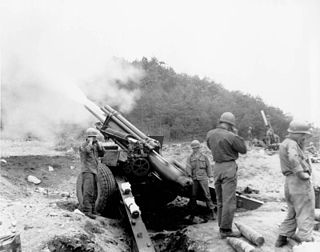
The howitzer is an artillery weapon that falls between cannon and a mortar. With their long-range capabilities, howitzers can be used to great effect in a battery formation with other artillery pieces, such as long-barreled guns, mortars, and rocket artillery.

Self-propelled artillery is artillery equipped with its own propulsion system to move toward its firing position. Within the terminology are the self-propelled gun, self-propelled howitzer, self-propelled mortar, and rocket artillery. They are high mobility vehicles, usually based on continuous tracks carrying either a large field gun, howitzer, mortar, or some form of rocket/missile launcher. They are usually used for long-range indirect bombardment support on the battlefield.

The 8 inch (203 mm) M110 self-propelled howitzer is an American self-propelled artillery system consisting of an M115 203 mm howitzer installed on a purpose-built chassis. Before its retirement from US service, it was the largest available self-propelled howitzer in the United States Army's inventory; it continues in service with the armed forces of other countries, to which it was exported. Missions include general support, counter-battery fire, and suppression of enemy air defense systems.
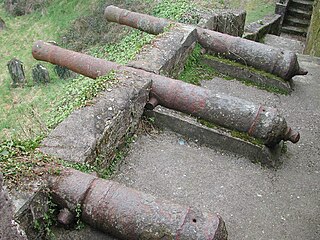
In military organizations, an artillery battery is a unit or multiple systems of artillery, mortar systems, rocket artillery, multiple rocket launchers, surface-to-surface missiles, ballistic missiles, cruise missiles, etc., so grouped to facilitate better battlefield communication and command and control, as well as to provide dispersion for its constituent gunnery crews and their systems. The term is also used in a naval context to describe groups of guns on warships.
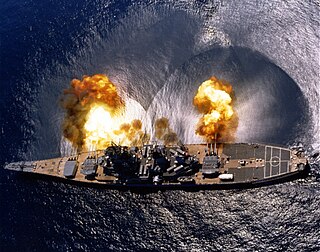
Naval gunfire support (NGFS), also known as naval surface fire support (NSFS), or shore bombardment, is the use of naval artillery to provide fire support for amphibious assault and other troops operating within their range. NGFS is one of several disciplines encompassed by the term naval fires. Modern naval gunfire support is one of the three main components of amphibious warfare assault operations support, along with aircraft and ship-launched land-attack missiles. Shipborne guns have been used against shore defences since medieval naval warfare.

In military science, suppressive fire is "fire that degrades the performance of an enemy force below the level needed to fulfill its mission". When used to protect exposed friendly troops advancing on the battlefield, it is commonly called covering fire. Suppression is usually only effective for the duration of the fire. It is one of three types of fire support, which is defined by NATO as "the application of fire, coordinated with the maneuver of forces, to destroy, neutralise or suppress the enemy".

An artillery observer,artillery spotter, or forward observer (FO) is a soldier responsible for directing artillery and mortar fire support onto a target. An artillery observer usually accompanies a tank or infantry unit. Spotters ensure that indirect fire hits targets which those at a fire support base cannot see.

A ranged weapon is any weapon that can engage targets beyond hand-to-hand distance, i.e. at distances greater than the physical reach of the user holding the weapon itself. The act of using such a weapon is also known as shooting. It is sometimes also called projectile weapon or missile weapon because it typically works by launching solid projectiles ("missiles"), though technically a fluid-projector and a directed-energy weapon are also ranged weapons. In contrast, a weapon intended to be used in hand-to-hand combat is called a melee weapon.
Counter-battery fire is a battlefield tactic employed to defeat the enemy's indirect fire elements, including their target acquisition, as well as their command and control components. Counter-battery arrangements and responsibilities vary between nations but involve target acquisition, planning and control, and counter-fire. Counter-battery fire rose to prominence in World War I.
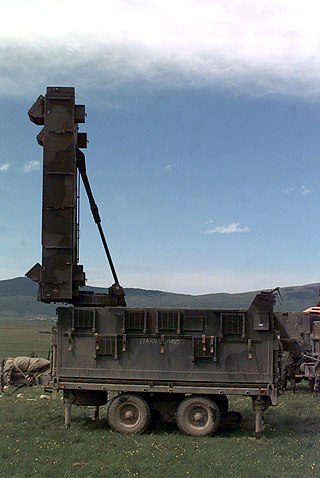
Shoot-and-scoot is an artillery tactic of firing at a target and then immediately moving away from the location from where the shots were fired to avoid counter-battery fire.

The M107 175 mm self-propelled gun was used by the U.S. Army and U.S. Marine Corps from the early 1960s to the late 1970s. It was part of a family of self-propelled artillery that included the M110. It was intended to provide long-range fire support in an air-transportable system. It was exported to several other countries including Germany, South Korea, Spain, Greece, Iran, Israel, Italy, the Netherlands, the United Kingdom, and Turkey. The M107's combat history in U.S. service was limited to the Vietnam War; it also saw extensive combat use in Israeli service. The M107 shared many components with, and in many cases was replaced by, later versions of the M110 203 mm howitzer. Although withdrawn from U.S. service in the late 1970s, it continues in service with some armies as of 2019.

Fire discipline is a system of communication in the military, primarily for directing artillery. By definition, fire discipline is the language of fire control. It consists of words, phrases, rules, and conventions which have specific meanings and which result in some definite action being taken with the guns. All ranks concerned in fire control must be thoroughly familiar with the language and the resulting actions. The aim of fire discipline is to ensure that in response to calls for fire, the appropriate action is taken at the FPC, FSCC, FDC and at the Guns/MRL, strictly in accordance with the intentions of the originator and with the minimum of delay.

In the US system for land-based field artillery, the field artillery team is organized to direct and control indirect artillery fire on the battlefield.

The Royal Garrison Artillery (RGA) was formed in 1899 as a distinct arm of the British Army's Royal Regiment of Artillery serving alongside the other two arms of the Regiment, the Royal Field Artillery (RFA) and the Royal Horse Artillery (RHA). The RGA were the 'technical' branch of the Royal Artillery who were responsible for much of the professionalisation of technical gunnery that was to occur during the First World War. It was originally established to man the guns of the British Empire's forts and fortresses, including coastal artillery batteries, the heavy gun batteries attached to each infantry division and the guns of the siege artillery. The RGA was amalgamated with the RFA in 1924, from which time the only two arms within the Royal Regiment of Artillery have been the Royal Artillery and the Royal Horse Artillery.

The Artillery Battalion is the Norwegian army's Brigade Nords artillery battalion. The unit numbers some 550 soldiers and officers.

The Obusier de 6 pouces Gribeauval or 6-inch howitzer was a French artillery piece and part of a system established by Jean Baptiste Vaquette de Gribeauval. The Old French inch was 1.066 English inches long so the weapon can accurately be described as a 6.4-inch howitzer.

Direct fire or line-of-sight fire refers to firing of a ranged weapon whose projectile is launched directly at a target within the line-of-sight of the user. The firing weapon must have a sighting device and an unobstructed view to the target, which means no obstacles or friendly units can be between it and the target. A weapon engaged in direct fire conversely exposes itself to direct return fire from the target.

The Canon de 4 Gribeauval or 4-pounder was a French cannon and part of the artillery system developed by Jean Baptiste Vaquette de Gribeauval. The Old French pound was 1.079 English pounds, making the weight of shot about 4.3 English pounds. In the Gribeauval era, the 4-pounder was the lightest weight cannon of the French field artillery; the others were the medium Canon de 8 Gribeauval and the heavy Canon de 12 Gribeauval. The Gribeauval system was introduced in 1765 and the guns were first employed during the American Revolutionary War. The most large-scale use of Gribeauval guns occurred during the French Revolutionary Wars and the Napoleonic Wars. At first a pair of 4-pounders were assigned to each infantry battalion and were often called battalion pieces. Later, Emperor Napoleon took the guns away from the infantry units and began to replace the 4-pounder with the 6-pounder, using captured guns as well as newly cast French cannons. However, as the French infantry declined in quality after 1809, the 4-pounders were reintroduced in order to provide direct support for formations of foot soldiers. All Gribeauval cannons were capable of firing canister shot at close-range and round shot at long-range targets. The Gribeauval system supplanted the older Vallière system, was partly replaced by the Year XI system in 1803 and completely superseded by the Valée system in 1829.




